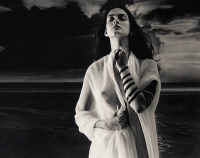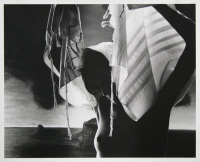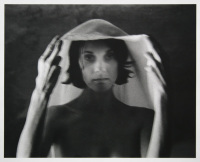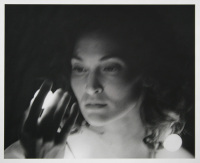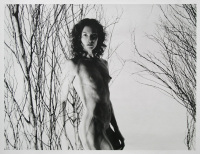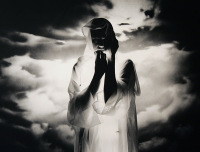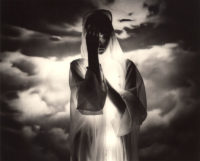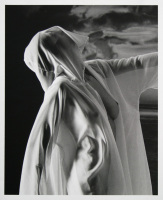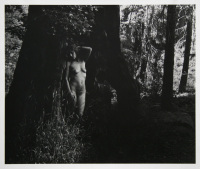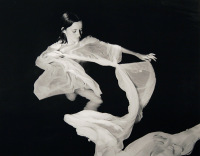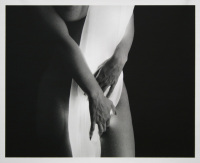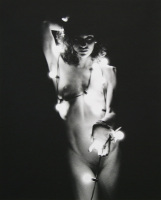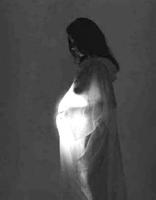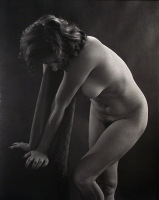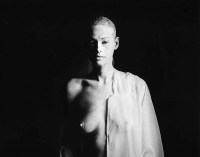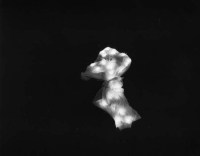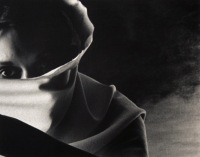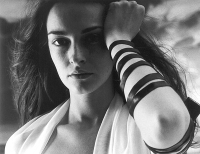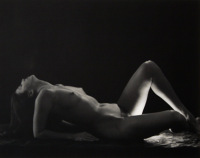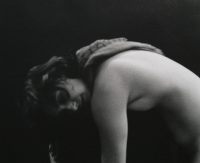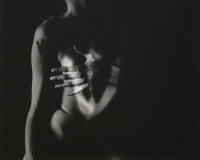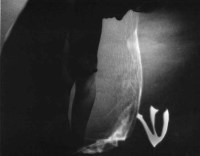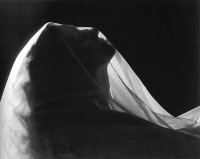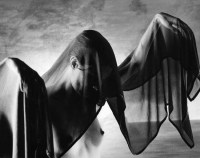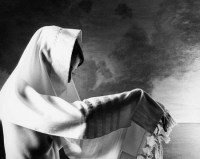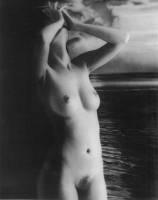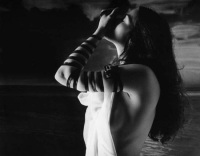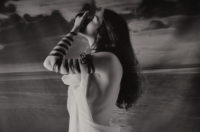Leonard Nimoy: Shekhina
Shekhina
Hardcover
Signed and unsigned books are available.
When Leonard Nimoy’s book of photography, Shekhina, was published in 2002, it created a ruckus. His depiction of alluringly glamorous women — some wearing tefillin in all their naked glory — as the essence of the feminine manifestation of God struck some as revolutionary and others as salacious. The book sold well, and even inspired a ballet aptly named, Shekhina by a New York choreographer.
A feminine word in Hebrew, Shekhina is the Talmudic term for the visible and audible manifestations of the Deity’s presence on Earth. Over time, Shekhina came to represent much more — a softer, empathetic feminine counterpart to God who could argue for humanity’s sake, comfort the poor and sick, and stand as the mother of Israel. Nimoy’s first encounter with the mystique of Shekhina began in synagogue at the age of 8. “The men were chanting, shouting and praying in an Orthodox service. It was very passionate, very theatrical,” said Nimoy. His father told him not to look, as the worshippers averted their eyes during blessings recited by the kohanim, or descendants of the priestly class. “I was chilled by the whole thing,” he said. Years later Nimoy’s rabbi explained to him that the entry of Shekhina into the sanctuary to bless the congregation could cast a fatally blinding light. Such a powerful memory inspired the actor/photographer to explore the feminine aspect of God in human form, including the issues of sensuality and sexuality.
To Nimoy, sexuality and spirituality are not segregated. “There are signs throughout the writings and history of Judaism that sexuality has always been a strong part of the teaching and culture of religious practice,” said Nimoy, citing the examples of the Friday night bath to cleanse before sex and the teachings of the Kabbalists.
Leonard Nimoy talks about the Shekhina Project on the TV show Sex and Religion.
“Nimoy is a gnostic mystic—a radical spiritualist, indeed, a spiritual rebel…I am suggesting that Nimoy’s fascination with the female body involves an element of temptation as well as transcendence. I am suggestion that what is really unusual about his female figures is that they signify profane and sacred love simultaneously…The issue that Nimoy’s photographs subtly address is the transmutation of sexual desire into spiritual aspiration…It is Nimoy’s ability to convey woman’s many-sidedness—Shekhina and Succubus at once—that makes his photographs profound.” — Donald Kuspit
11×14 in
11×14 in
16×20 in
11×14 in
16×20 in
11×14 in
16×20 in
16×20 in
11×14 in
16×20 in
11×14 in
“…with Shekhina, Nimoy… is igniting an artistic debate…over art and censorship that echoes the battles that swirled over Mapplethorpe, and other artists like Andres Serrano and Chris Ofili, who created controversial religious imagery.” — Jewish Telegraphic Agency
14×11 in
11×14 in
11×14 in
16×20 in
11×14 in
“I have long admired Leonard Nimoy’s bewitching photographs. Now, with the publication of Shekhina, I understand the importance of his urgent and paradoxical quest to make the invisible visible. He has revealed the feminine aspect of spirituality in all its complex beauty.” — Erica Jong
14×11 in
14×11 in
20×16 in
11×14 in
11×14 in
11×14 in
11×14 in
“The lure of Nimoy’s images bespeaks hours in the darkroom. It is there one understands that we live in a world of darkness injected with light. Leonard has wisely used this knowledge to implement his vision of God, or perhaps it is inversely so… I like getting to think about God through formalism. And I’ve always liked considering God as a woman.” — John Baldessari
11×14 in
11×14 in
11×14 in
16×20 in
11×14 in
11×14 in
11×14 in
“In SHEKHINA, he fuses his love of the camera with his Orthodox Jewish upbringing… Nimoy’s women emerge from the darkness as sensual beacons. They explore the mythology of Kabbalism and Nimoy’s own spirituality.” — Time Out New York
14×11 in
11×14 in
16×20 in
“Credit actor Leonard Nimoy, Mr. Spock of “Star Trek,” with this season’s most beautiful photography monograph, “Shekhina”. He took his subject from the Jewish scriptural mythology that says God created a divine feminine presence to dwell among humanity. His first encounter with the mystery and power of Shekhina came as a child when he attended the Orthodox Jewish service with the men of his family and was forbidden to raise his eyes to the blessing of the invisible deity. Ever since, Nimoy, now in his 70s, has been seeking to create an image of Shekhina that is at once spiritual and sensuous. He succeeds brilliantly, proving himself to be a photographer of great vision and sensitivity.” — Detroit News
“There may be no richer subject for a Google search than Leonard Nimoy. While this is due in large part to the enduring fanaticism of Star Trek mavens, it’s also the consequence of Nimoy’s remarkably varied interests… Perhaps it shouldn’t comes as a surprise, then, that Nimoy, a talented and dedicated photographer, is now also releasing his first monograph…. His visual work is getting deserved attention.” — American Photo
See photographs from Leonard Nimoy’s Shekhina opening reception at the R. Michelson Galleries.
Mr. Nimoy’s original photography ranges in price from $1,500 to $25,000 dependent on image, size of image (which range from 5″ x 7″ inches to life-size 67″ x 80″), and size of edition (all are small editions of between 2 and 25). B&W images were shot with film and hand printed by Mr. Nimoy in his darkroom. Color images are digital and the printing was personally supervised by Mr. Nimoy. All photographs are signed and numbered.


